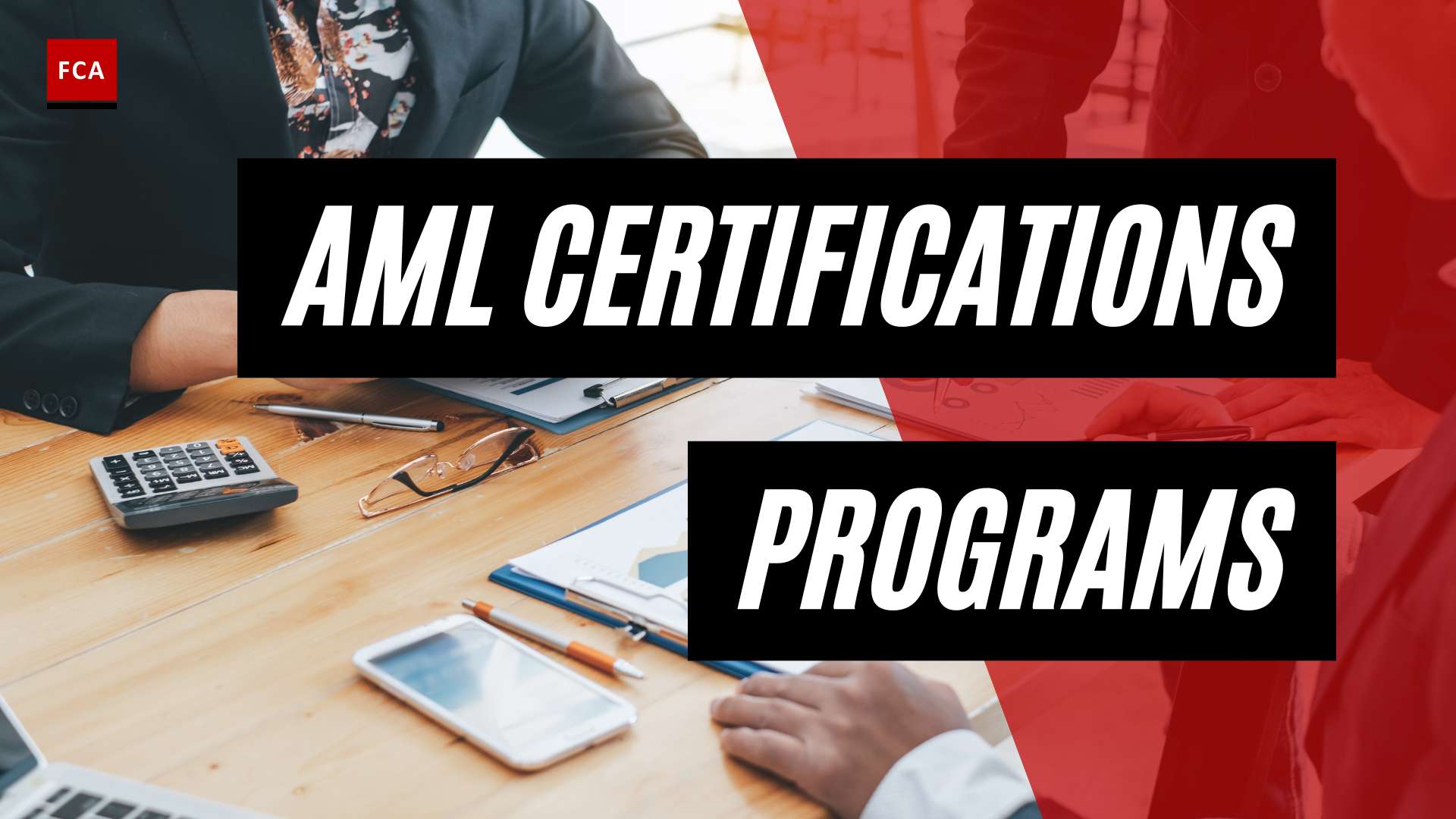Understanding AML Compliance Programs
To combat money laundering and terrorist financing, financial institutions are required to establish robust Anti-Money Laundering (AML) compliance programs. These programs play a crucial role in preventing and detecting suspicious activities within the financial system. Understanding the importance of AML compliance and the key components of an AML compliance program is essential for professionals working in compliance, risk management, anti-money laundering, and anti-financial crime.
Importance of AML Compliance
AML compliance programs are essential for financial institutions to prevent and detect money laundering or terrorist financing. Regulatory frameworks, such as the Bank Secrecy Act (BSA) in the U.S. and Anti-Money Laundering Directives in the EU, guide these programs. The importance of AML compliance cannot be overstated, as it helps protect the integrity of the financial system, maintain customer trust, and mitigate reputational and regulatory risks (Flagright).
By implementing effective AML compliance programs, financial institutions demonstrate their commitment to combating financial crime, meeting legal obligations, and contributing to global efforts to combat money laundering and terrorist financing.
Components of an AML Compliance Program
An effective AML compliance program comprises several key components that work together to ensure adherence to regulatory requirements and industry best practices. These components include:
- Written Policies and Procedures: Financial institutions must establish comprehensive written policies and procedures that cover all aspects of AML compliance. These policies should provide clear guidelines for internal operations and monitoring processes, enhancing compliance throughout the institution. These policies should align with applicable AML compliance regulations and address risk assessment, customer due diligence, transaction monitoring, reporting, and record-keeping.
- Customer Risk Assessments and Due Diligence: AML compliance programs should include robust customer risk assessments during onboarding and periodic re-evaluations. This process helps identify high-risk customers and transactions and ensures compliance with Know Your Customer (KYC) requirements (Flagright). Financial institutions must assess risk factors related to products, services, transaction patterns, geographic locations, and high-risk individuals, among others, to tailor their compliance efforts effectively.
- Internal Controls and Independent Testing: To ensure compliance with AML regulations, financial institutions must establish and maintain effective internal controls. These controls include procedures, systems, and processes that identify, monitor, and mitigate money laundering and terrorist financing risks. Regular internal reviews and independent testing by qualified third-party organizations are crucial to assess the effectiveness of these controls and identify areas for improvement (Flagright).
- AML Compliance Officer: Each financial institution should designate an AML compliance officer responsible for overseeing the institution’s compliance with AML laws and regulations. The compliance officer plays a critical role in designing and implementing effective AML compliance programs, ensuring the institution’s board and senior management are informed about the compliance status, and staying abreast of evolving AML regulations (Lowers Risk Group). The compliance officer should possess the necessary expertise and training to fulfill their responsibilities effectively.
By incorporating these key components into their AML compliance programs, financial institutions can better safeguard their operations, protect against financial crime, and meet regulatory requirements. It is crucial for institutions to stay updated on AML compliance regulations and adapt their programs as necessary to address emerging risks and changing regulatory landscapes.
In the next section, we will explore in further detail how to develop an effective AML training program, which is a vital component of an overall AML compliance program.
Developing an Effective AML Training Program
When it comes to AML compliance, developing a comprehensive and effective training program is crucial for financial institutions. AML training plays a vital role in ensuring compliance with regulations and protecting institutions and the financial system from money laundering, terrorist financing, and other financial crimes (FCA).
Role of AML Training in Compliance
The role of AML training is to provide employees with the knowledge and skills necessary to identify and prevent suspicious activities, understand regulatory requirements, and adhere to internal policies and procedures. By receiving proper training, employees can contribute to maintaining a strong culture of compliance within the organization.
AML training programs aim to educate employees on the importance of detecting and reporting potential money laundering activities. They also emphasize the significance of customer due diligence, risk assessments, and suspicious activity reporting (FCA). By instilling this knowledge, financial institutions can enhance their ability to identify and mitigate risks associated with illicit financial activities.
Key Topics to Include in AML Training
An effective AML training program should cover a range of key topics to ensure that employees have a comprehensive understanding of their roles and responsibilities in AML compliance. Some essential topics to include are:
- Bank Secrecy Act (BSA) and AML Laws: Provide an overview of the BSA, its purpose, and the legal framework for AML compliance. Explain the roles of regulatory bodies, such as the Financial Crimes Enforcement Network (FinCEN), in enforcing AML laws and regulations.
- Risk Assessments and Customer Due Diligence: Educate employees on the importance of conducting risk assessments and implementing appropriate customer due diligence measures. Highlight the significance of Know Your Customer (KYC) procedures and the identification and verification of customer information.
- Suspicious Activity Reporting: Train employees on how to recognize and report suspicious activities effectively. Provide examples of red flags and indicators of potential money laundering or terrorist financing activities.
- Internal Controls and Recordkeeping: Emphasize the importance of establishing robust internal controls and recordkeeping practices to ensure compliance with AML regulations. Discuss the documentation requirements for AML compliance and the importance of maintaining accurate and up-to-date records.
- Emerging Trends and Technologies: Keep employees informed about the latest trends, typologies, and emerging technologies related to money laundering and financial crime. Encourage ongoing education and awareness to stay ahead of evolving risks.
By covering these key topics in AML training, financial institutions can equip their employees with the necessary knowledge and skills to fulfill their responsibilities in combating money laundering and related financial crimes.
Financial institutions have various options for implementing AML training programs, including industry certification programs and training resources offered by professional organizations like (FCA). These programs provide access to learning resources, webinars, podcasts, and other materials to enhance the knowledge and skills of individuals involved in AML compliance. Institutions can also develop their own training materials and resources tailored to their specific needs and requirements.
By investing in a robust AML training program, financial institutions can foster a culture of compliance, protect themselves from potential risks, and contribute to the overall integrity and stability of the financial system.
Implementing AML Training for Financial Institutions
To effectively combat money laundering and ensure compliance with anti-money laundering (AML) regulations, financial institutions must implement comprehensive AML training programs. These programs play a crucial role in equipping employees with the knowledge and skills necessary to identify and prevent illicit financial activities. Two key aspects of implementing an AML training program for financial institutions are industry certification programs and training resources and materials.
Training Resources and Materials
In addition to industry certifications, financial institutions should provide employees with access to training resources and materials to enhance their AML knowledge and skills. These resources can include online courses, webinars, podcasts, articles, and other educational materials. FCA, for example, offers a variety of learning resources through its platform, including webinars and podcasts, to help professionals enhance their knowledge and skills in anti-money laundering practices.
Financial institutions can also develop their own training materials tailored to their specific policies, procedures, and compliance requirements. These materials should cover various topics relevant to AML compliance, such as recognizing red flags, conducting customer due diligence, identifying suspicious transactions, and reporting suspicious activity. It is important to ensure that the training materials are regularly updated to reflect changes in AML regulations and emerging trends in financial crime.
By providing employees with access to comprehensive training resources and materials, financial institutions can foster a culture of compliance and equip their staff with the necessary tools to effectively identify and report suspicious activities.
Implementing an AML training program for financial institutions is essential for ensuring compliance with AML regulations and protecting institutions and the financial system from money laundering, terrorist financing, and other financial crimes. Through industry certification programs and comprehensive training resources, employees can acquire the knowledge and skills needed to fulfill their responsibilities in preventing illicit financial activities. By investing in AML training, financial institutions can demonstrate their commitment to combating financial crime and safeguarding the integrity of the global financial system.
Ensuring Compliance with AML Regulations
To effectively combat money laundering and terrorist financing, financial institutions must establish robust AML compliance programs that adhere to regulations such as the Bank Secrecy Act in the U.S. and Anti-Money Laundering Directives in the EU. Two critical components of these programs are conducting risk assessments and implementing internal controls and independent testing.
Risk Assessments and Customer Due Diligence
A thorough risk assessment is a crucial first step in developing an effective AML compliance program for financial institutions. It involves identifying the inherent risks associated with the institution’s business and evaluating risk categories related to products, services, customers, and geographic locations. By understanding these risks, institutions can tailor their compliance programs to mitigate them effectively.
Customer due diligence (CDD) is an integral part of risk assessment. It involves verifying the identity of customers, assessing their risk profiles, and monitoring their transactions. Through CDD, financial institutions can identify potentially suspicious activities and take appropriate actions, such as enhanced due diligence for high-risk customers.
By conducting comprehensive risk assessments and implementing robust customer due diligence procedures, financial institutions can better identify and manage the risks associated with money laundering and terrorist financing.
Internal Controls and Independent Testing
Internal controls play a crucial role in ensuring AML compliance within financial institutions. These controls involve the establishment of policies, procedures, and processes that guide employees in detecting and reporting suspicious activities. Internal controls review is an essential part of the AML compliance program, ensuring that the institution’s policies and procedures align with regulatory requirements.
Conducting independent testing, also known as an audit, is a key principle in AML compliance programs. Financial institutions should perform a risk-based audit at least once every 12 to 18 months, or more frequently for higher-risk institutions. The purpose of the independent testing is to assess the organization’s risk profile, evaluate the effectiveness of its compliance program, and identify any deficiencies or areas for improvement. This audit is typically conducted by qualified third-party organizations to ensure objectivity and integrity.
By implementing strong internal controls and conducting regular independent testing, financial institutions can demonstrate their commitment to AML compliance and uncover any weaknesses or gaps in their compliance programs.
To stay compliant with AML regulations, financial institutions must continuously monitor and update their AML compliance programs, adapting to regulatory changes as they arise. By conducting risk assessments, implementing internal controls and independent testing, institutions can significantly strengthen their ability to detect and prevent money laundering and terrorist financing activities.
The Role of AML Compliance Officers
AML compliance officers play a crucial role in ensuring that financial institutions adhere to anti-money laundering regulations. These professionals are responsible for overseeing and implementing effective AML compliance programs within their organizations. Let’s explore their responsibilities, expertise, and training requirements in more detail.
Responsibilities and Expertise
Each financial institution is required to designate a BSA/AML Compliance Officer who should be well-versed in BSA/AML regulations, have the expertise to design and implement compliance programs, and ensure the organization’s Board and senior management are informed about the compliance status of the institution (Lowers Risk Group). The primary responsibilities of AML compliance officers include:
- Designing and Implementing AML Compliance Programs: AML compliance officers are responsible for developing and implementing comprehensive AML compliance programs tailored to the specific risks and needs of their organization. This involves establishing policies, procedures, internal controls, and risk assessment processes to detect, prevent, and report potential money laundering and terrorist financing activities.
- Monitoring Compliance: AML compliance officers must conduct ongoing monitoring and testing of their institution’s AML program to ensure its effectiveness and identify any vulnerabilities or gaps. This includes reviewing transactions, conducting audits, and maintaining records to support compliance efforts.
- Reporting Suspicious Activity: AML compliance officers are responsible for filing Suspicious Activity Reports (SARs) when they identify transactions or patterns that may indicate money laundering, terrorist financing, or other illicit activities. They must have a thorough understanding of the red flags and indicators of suspicious activity to fulfill this duty effectively.
- Staying Updated on Regulations: AML compliance officers must stay abreast of the evolving regulatory landscape and ensure that their institution’s AML program remains current and in line with the latest requirements. This involves understanding regulatory guidance, monitoring industry best practices, and participating in relevant training and professional development opportunities.
Training Requirements for Compliance Officers
To fulfill their responsibilities effectively, AML compliance officers should possess a strong understanding of AML regulations, risk management principles, and industry best practices. The specific training requirements for compliance officers may vary depending on the jurisdiction and the nature of the financial institution. However, some common training topics and areas of expertise include:
- AML Regulations and Laws: Compliance officers must have a comprehensive understanding of relevant AML laws and regulations, such as the Bank Secrecy Act (BSA) and the USA PATRIOT Act. They should be familiar with the requirements set forth by regulatory bodies, such as the Financial Crimes Enforcement Network (FinCEN), and understand the obligations imposed on their institution.
- Risk Assessment and Customer Due Diligence: AML compliance officers need to be proficient in conducting risk assessments and implementing effective customer due diligence (CDD) processes. This includes verifying customer identities, assessing customer risk profiles, and implementing enhanced due diligence measures for high-risk customers.
- Internal Controls and Independent Testing: Compliance officers should have a strong understanding of internal control frameworks and be able to design and implement controls to mitigate money laundering risks. They should also be knowledgeable about independent testing requirements and be able to coordinate or conduct internal and external audits to evaluate the effectiveness of AML programs.
- Emerging Risks and Technologies: AML compliance officers should stay informed about emerging risks and trends in money laundering, such as virtual currencies, cybercrime, and trade-based money laundering. They should also have a basic understanding of technologies and tools utilized in AML compliance, such as transaction monitoring systems and Know Your Customer (KYC) solutions.
By possessing the necessary expertise and staying current with industry developments and regulatory changes, AML compliance officers can effectively lead their institutions in combatting financial crime and maintaining a strong culture of compliance.
Note: To access the full content, please visit the provided links.
Challenges and Best Practices in AML Training
Developing and implementing an effective AML training program is crucial for organizations to combat money laundering and ensure compliance with regulatory requirements. However, there are several challenges that companies may face in this process. By understanding these challenges and implementing best practices, organizations can design and deliver effective AML training programs.
Adapting to Regulatory Changes
Money laundering techniques are constantly evolving, making it essential for AML training programs to keep up with regulatory changes. The Financial Action Task Force (FATF) has reported that money laundering is becoming more complex and sophisticated due to the rise of new technologies, making it increasingly challenging to detect and prevent (Sanction Scanner). To address this challenge, AML training programs should include up-to-date information on the latest regulations and emerging trends. This ensures that employees are equipped with the knowledge and skills necessary to identify and prevent money laundering activities.
Companies should establish processes to monitor regulatory updates and assess their impact on AML policies and procedures. Regular training updates should be provided to employees to ensure they are aware of any changes in regulations and understand their implications. By staying proactive and adaptable, organizations can effectively address the challenges posed by evolving regulatory landscapes.
Designing Effective Training Programs
Designing an effective AML training program requires careful consideration of various factors. Before developing the program, organizations should identify the target audience and tailor the content accordingly. Different roles within the organization may require specific training modules to address their unique AML responsibilities. For example, individuals in high-risk sectors such as banks, investment firms, and foreign exchange traders may require more specialized training (Sanction Scanner).
To ensure the success of the training program, organizations should allocate sufficient resources, including budget and time, for its development and implementation. Training content should cover relevant regulations from authorities such as FATF and OFAC, providing participants with a comprehensive understanding of their AML obligations (Sanction Scanner). The program should also incorporate engaging and interactive elements, such as case studies and quizzes, to maximize participant engagement and knowledge retention.
In addition, companies should consider the use of technology and digital tools to enhance the effectiveness of AML training. Online training platforms, webinars, and e-learning modules can provide flexibility and accessibility for employees, allowing them to undergo training at their own pace and convenience. This approach also enables organizations to track and monitor the progress and completion of training activities.
By following these best practices, organizations can develop and deliver AML training programs that effectively educate employees, enhance their skills, and ensure compliance with evolving regulatory requirements. This continuous investment in AML training not only protects the company from criminal attempts but also enhances its reputation and demonstrates a commitment to combating money laundering.








